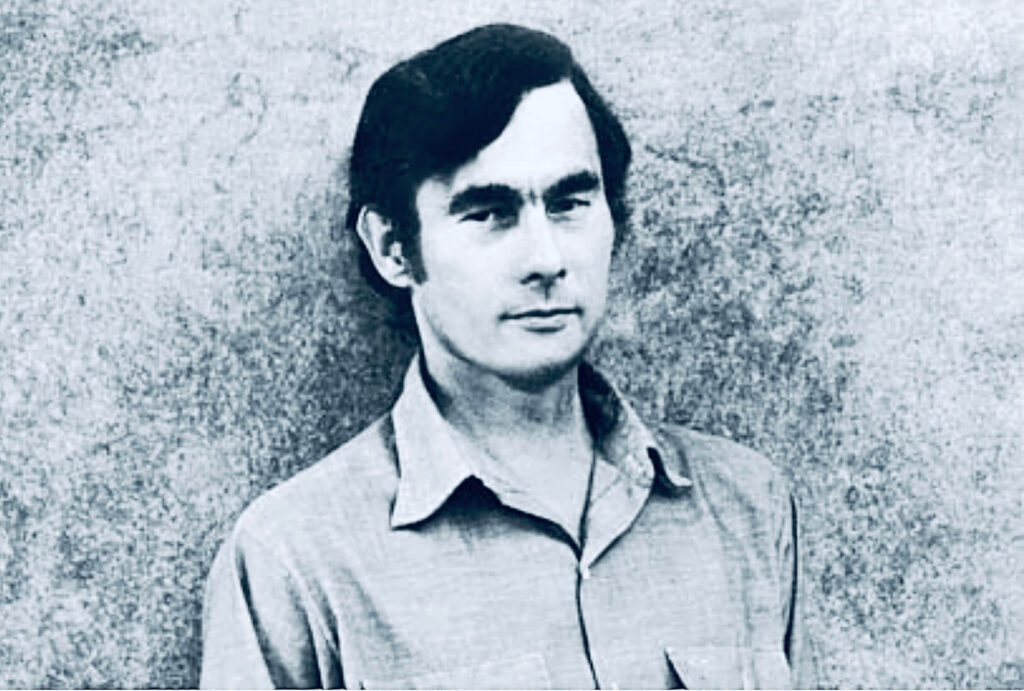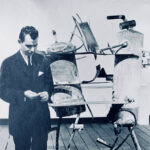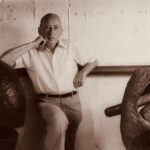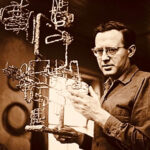Theodore Roszak
Theodore Roszak (1907-1981) was a pioneering American sculptor whose work bridged the gap between Abstract Expressionism and Constructivism. His innovative use of materials, including metal and industrial components, and his unique blend of abstraction and representation have made him a significant figure in 20th-century art. Over his prolific career, Roszak explored various artistic media and techniques, contributing to the evolution of modern sculpture.

Early Life and Education
Theodore Roszak was born on May 1, 1907, in Posen, Poland (now Poznań, Poland). His family immigrated to the United States when he was two years old, settling in Chicago. Growing up in a culturally rich environment, Roszak showed an early interest in art and engineering, influences that would later merge in his sculptural practice.
Roszak began his formal art education at the age of 13, attending night classes at the Art Institute of Chicago. His early exposure to the institution provided a foundation in traditional art forms, but it was his subsequent studies that broadened his artistic horizons. In 1925, he enrolled full-time at the Art Institute, where he studied painting and drawing. During this time, Roszak was particularly influenced by the work of El Greco and the early modernists.
After graduating in 1928, Roszak traveled to New York City, where he continued his studies at the National Academy of Design. However, feeling constrained by the academic approach, he moved to Europe in 1930 to immerse himself in the avant-garde art scene. In Paris, he encountered the works of Pablo Picasso, Georges Braque, and the Surrealists, while in Germany, he studied at the Bauhaus in Dessau. At the Bauhaus, Roszak was exposed to Constructivism and the ideas of László Moholy-Nagy and Josef Albers, which profoundly influenced his thinking about form and structure.
Return to the United States and Early Career
Roszak returned to the United States in 1931, bringing with him the modernist ideas he had absorbed in Europe. Settling in New York City, he began to establish himself as an artist and educator. During the 1930s, he worked for the Works Progress Administration (WPA) Federal Art Project, producing public murals and sculptures. His early works from this period were primarily figurative, reflecting the influence of Social Realism and the economic conditions of the Great Depression.
In the late 1930s and early 1940s, Roszak’s work began to evolve towards abstraction. Influenced by the dynamism and technology of the modern age, he started incorporating industrial materials and techniques into his sculptures. This shift marked the beginning of his mature style, characterized by an exploration of geometric forms, mechanical components, and organic structures.
Emergence as a Leading Sculptor
The 1940s and 1950s were a transformative period for Roszak, during which he emerged as a leading figure in American sculpture. His work during this time reflected a synthesis of Constructivist principles and the expressive energy of Abstract Expressionism. Roszak’s sculptures often combined welded steel and brass with found objects, creating complex assemblages that were both dynamic and evocative.
One of his significant works from this period is “Spectre of Kitty Hawk” (1946), a sculpture that exemplifies his interest in technology and flight. This piece, constructed from welded steel and brass, depicts a bird-like form poised for flight. The use of industrial materials and the emphasis on movement and tension highlight Roszak’s ability to convey both mechanical precision and organic vitality.
In 1951, Roszak was included in the landmark exhibition “Abstract Painting and Sculpture in America” at the Museum of Modern Art (MoMA) in New York. This exposure helped to solidify his reputation as a leading contemporary sculptor. Throughout the 1950s, he continued to experiment with new forms and materials, pushing the boundaries of traditional sculpture.
Important Artwork: “Forms in Orbit” (1960)
One of Theodore Roszak’s most significant and acclaimed works is “Forms in Orbit” (1960), a sculpture that exemplifies his mature style and his mastery of working with industrial materials.
“Forms in Orbit” (1960)
“Forms in Orbit” is a large-scale sculpture made from welded and painted steel. The work stands approximately ten feet tall and is characterized by its intricate forms, dynamic composition, and sense of movement. Roszak’s use of steel, combined with his precise welding techniques, allows him to create a sculpture that is both robust and delicate.
The composition of “Forms in Orbit” is both complex and harmonious, with various geometric and organic shapes intertwining in a balanced arrangement. The sculpture’s bold lines and intricate forms convey a sense of energy and motion, as if the elements are in a state of perpetual movement. Despite the apparent complexity, Roszak’s careful placement of each component creates a unified and coherent whole.
At the heart of “Forms in Orbit” is Roszak’s ability to transform industrial materials into expressive and evocative forms. By recontextualizing steel and other metal components, he challenges viewers to see beauty and meaning in everyday objects. The sculpture’s textured surfaces and dynamic shapes invite tactile engagement, while its intricate forms and complex composition evoke a sense of wonder and curiosity.
“Forms in Orbit” is significant not only for its artistic merits but also for its broader cultural implications. Created during a time of rapid technological advancement and exploration of space, the sculpture reflects Roszak’s response to the changing landscape of science and industry. It embodies a celebration of progress and innovation, while also acknowledging the potential for creativity and transformation in the most unlikely materials.
Later Career and Continued Innovation
Throughout the 1960s and 1970s, Roszak continued to refine his technique and expand his artistic repertoire. He experimented with new materials and processes, including the use of aluminum and fiberglass. His works from this period are characterized by their increased scale and complexity, as well as their exploration of new textures and forms.
In the 1960s, Roszak began creating large-scale public sculptures and architectural commissions, such as “Trinity Towers” (1968) in Dallas, Texas, and “Sentinel” (1971) at Lincoln Center in New York City. These works often incorporated a variety of materials, including metal, glass, and concrete, and were notable for their integration of art and architecture.
Roszak’s contributions to contemporary sculpture were increasingly recognized during his lifetime. He received numerous awards and honors, including a Guggenheim Fellowship in 1941 and a National Endowment for the Arts grant in 1970. His works were exhibited in major museums and galleries around the world, and he participated in important group shows such as the Venice Biennale.
Personal Life and Philosophy
Theodore Roszak’s personal life was marked by his dedication to his art and his passion for experimentation. He maintained a studio in New York City for much of his career but also spent significant time working in other locations, including Long Island and Connecticut. His love for technology and engineering extended beyond his sculptures; he was an avid inventor and held several patents for his innovative designs.
Roszak’s artistic philosophy was rooted in a belief in the transformative power of art. He viewed his sculptures as a way to challenge conventional perceptions and to reveal new possibilities within everyday materials. This approach is evident in the vitality and dynamism of his works, which continue to captivate and inspire viewers.
Despite facing periods of financial difficulty and critical indifference, Roszak remained committed to his artistic vision. His perseverance and dedication to his craft are reflected in the body of work he created, which stands as a testament to his talent and his belief in the importance of art.
Legacy and Influence
Theodore Roszak’s legacy as a sculptor lies in his ability to transform industrial materials into vibrant and expressive works of art. His innovative use of steel and other metals helped to redefine the possibilities of sculpture, challenging traditional boundaries and opening up new avenues for artistic expression.
Roszak’s influence can be seen in the works of subsequent generations of artists who have been inspired by his inventive approach and his emphasis on materiality. His sculptures, with their combination of abstraction and representation, continue to resonate with viewers and artists alike, reminding us of the potential for creativity and transformation in the everyday world.
Later Works and Continued Innovation
In the later years of his career, Roszak continued to experiment with new materials and techniques, creating works that expanded the boundaries of his practice. He revisited earlier themes and forms, often incorporating elements from his previous works into new compositions. This period saw the creation of large-scale installations and public sculptures, such as “Night Presence II” (1975) and “Spire of Fire” (1981), which further solidified his reputation as a leading figure in contemporary art.
Roszak’s later works also reflected his ongoing engagement with color and form. He often used brightly colored, industrially coated metals, which added a sense of vibrancy and immediacy to his sculptures. His ability to balance spontaneity with control, and to create order from chaos, remained a hallmark of his work throughout his career.
Death and Posthumous Recognition
Theodore Roszak passed away on September 2, 1981, in New York City, leaving behind a rich legacy of artistic innovation and creativity. His contributions to contemporary sculpture have been widely recognized, and his works are included in the collections of major museums and galleries around the world, including the Museum of Modern Art in New York, the Guggenheim Museum, and the Smithsonian American Art Museum in Washington, D.C.
Since his death, Roszak’s work has continued to be celebrated through numerous exhibitions and retrospectives. His influence on contemporary art remains significant, and his sculptures continue to inspire new generations of artists and viewers.
Conclusion
Theodore Roszak’s artistic journey is a testament to his creativity, resilience, and profound understanding of form and material. Through his innovative approach to sculpture, he created a body of work that continues to inspire and challenge viewers. “Forms in Orbit,” one of his most important works, exemplifies his ability to convey complex ideas and emotions through abstract means.
In celebrating Theodore Roszak’s life and work, we recognize his significant contributions to the development of modern sculpture and his enduring legacy as an artist who saw potential and beauty in the overlooked and discarded. His sculptures remain powerful and evocative, reminding us of the transformative potential of art and the importance of seeing the world through new eyes. Roszak’s exploration of form and material continues to resonate, inviting us to contemplate the hidden possibilities that lie within the everyday objects around us.



